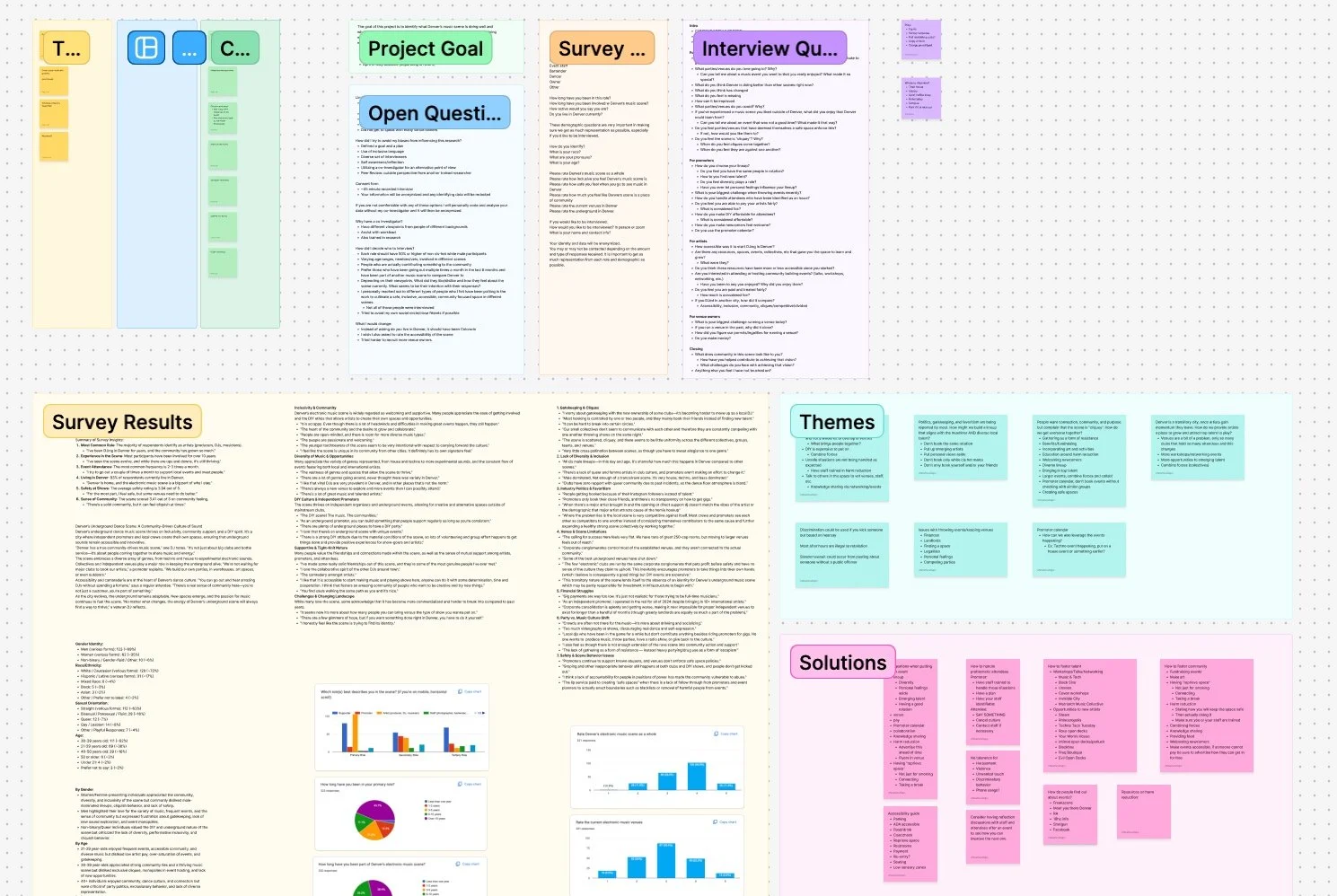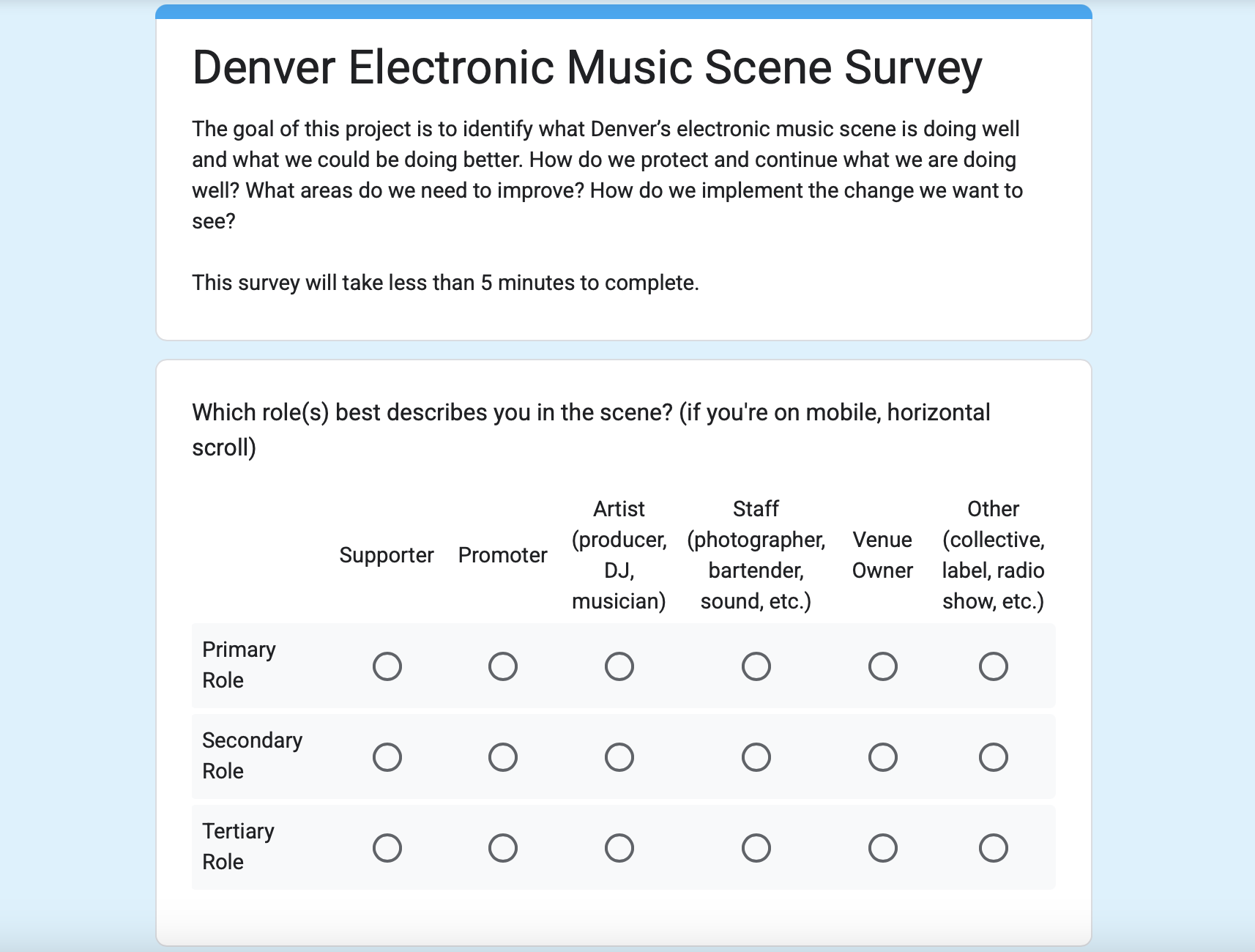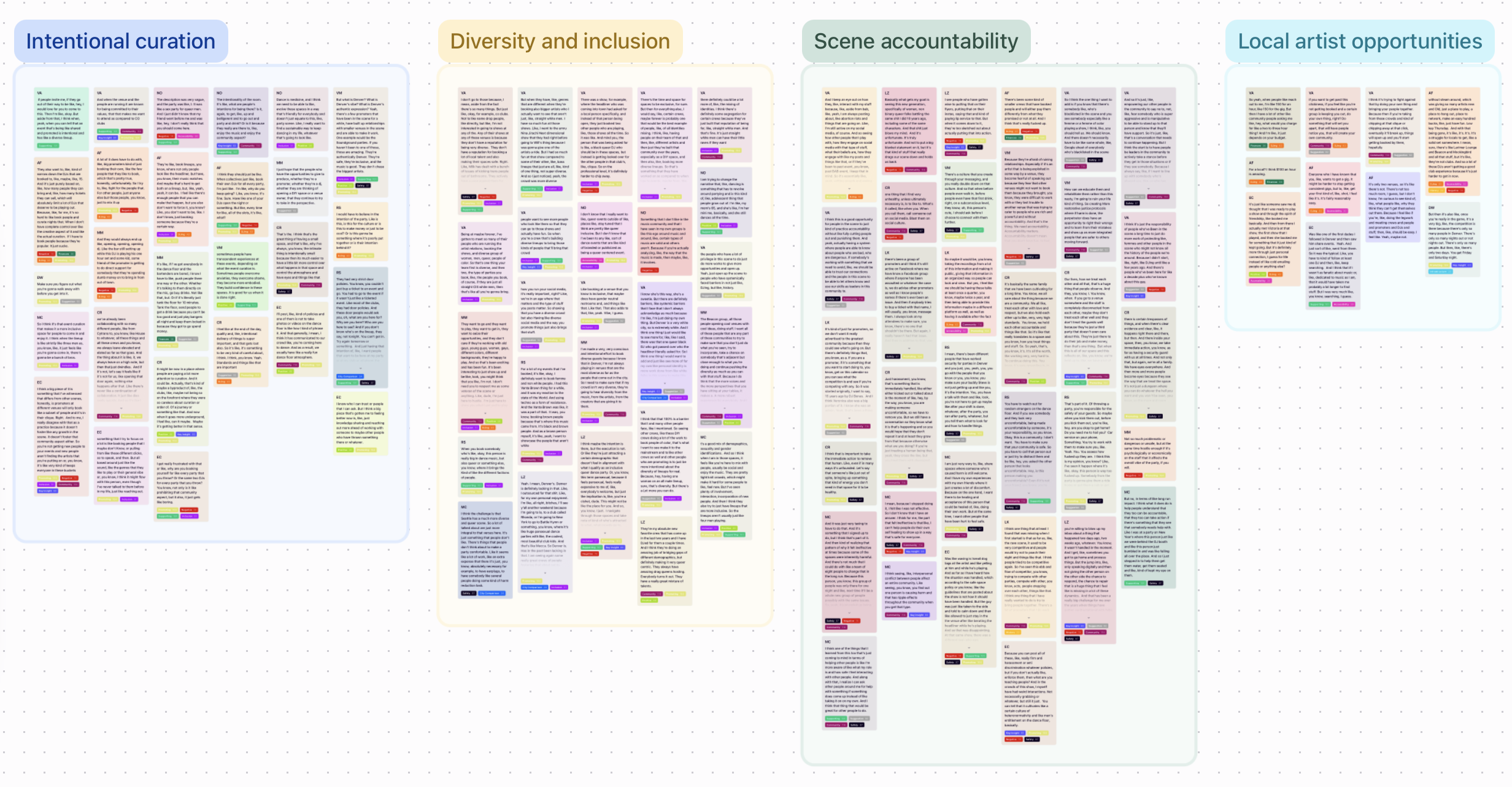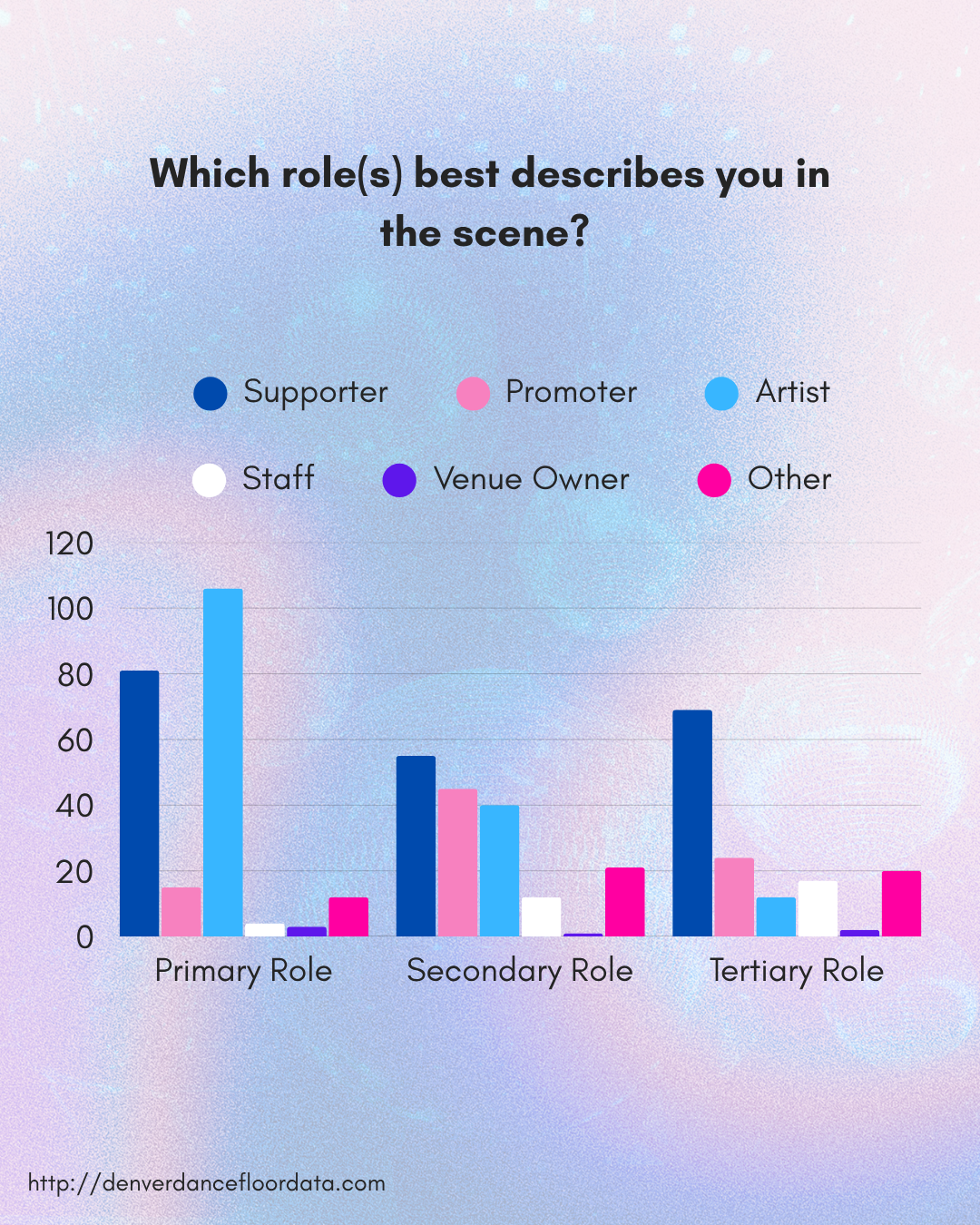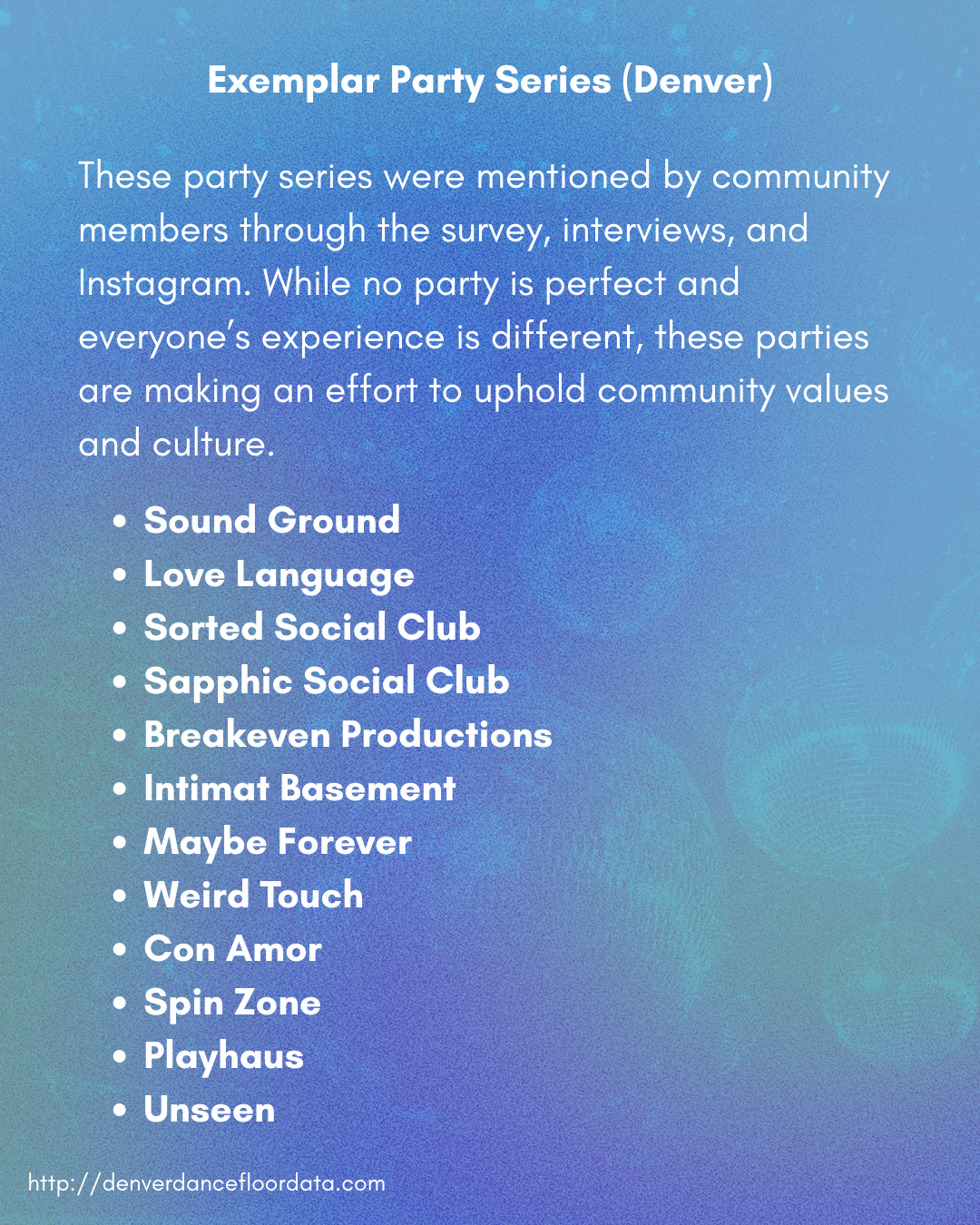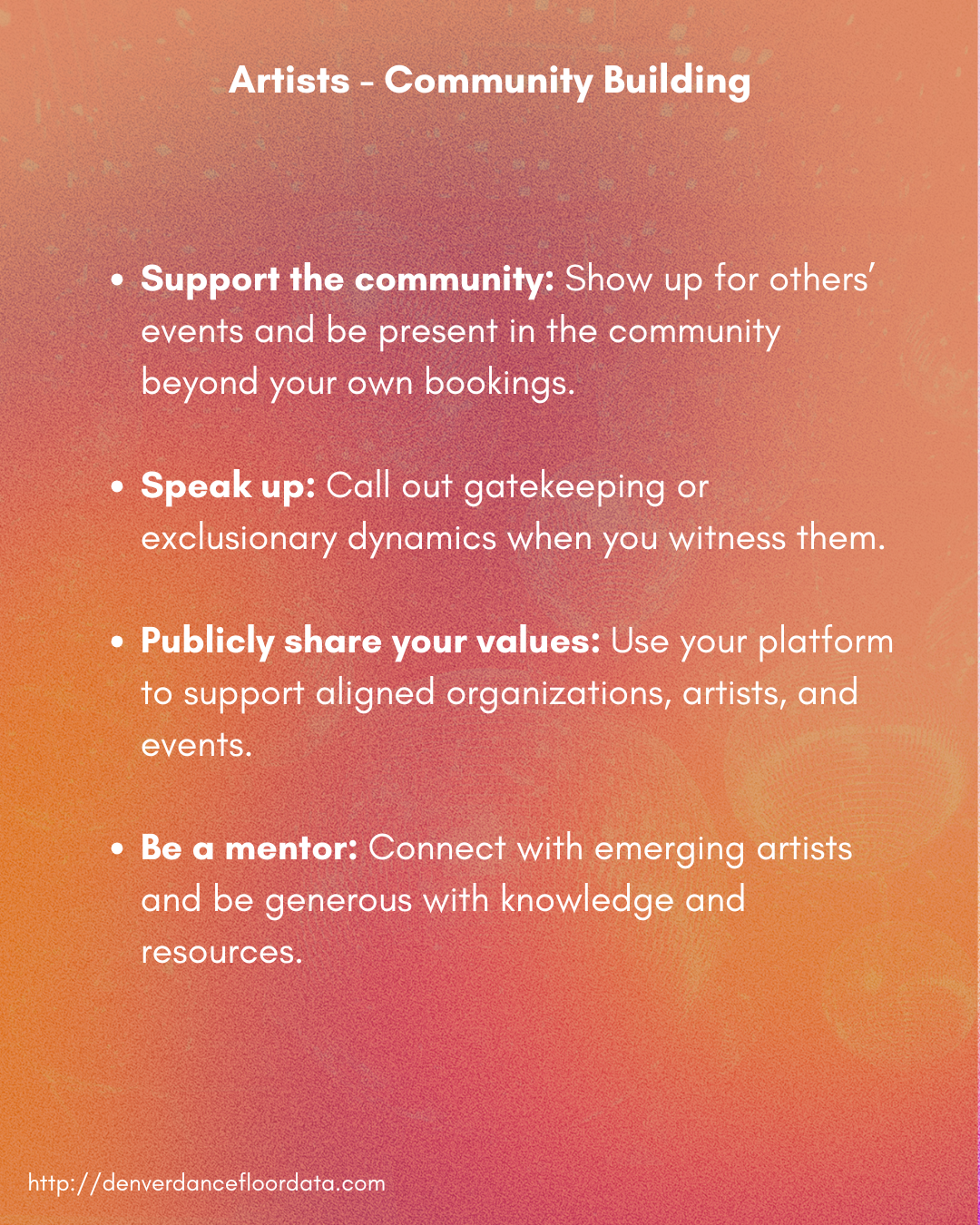
Denver Dancefloor Data
This research project on the current state of the Denver electronic music scene was conducted by Stephanie Chesler (Gramsie) in 2025. She surveyed 222 community members and interviewed 13 of them. The findings are shared not as a final answer, but as an offering, organized to help us reflect on our roles and consider how we might better serve the community we know and love.
Introduction
I embarked on this passion project for a few reasons. For one, I deeply care about this community. I was introduced to Denver’s electronic music scene in 2011 and moved here in 2015. I started going to shows put on by Afterhours Anonymous and The Hundred. As my intentions and tastes evolved, I began using Resident Advisor in 2018 to discover DIY events. Fast forward to 2024, I decided to pursue DJing seriously and got more involved in the scene. Leaning into what I loved introduced me to like-minded individuals, and this project has connected me to even more of them, and for that, I’m deeply grateful.
Second, since becoming a DJ, I have heard many people express frustration about the current state of Denver’s electronic music scene. Many believe they have all the answers. I thought to myself: I am trained to gather feedback and present it in a way that suggests potential solutions. By combining my love for research, music, and community, I’m able to utilize my professional background—I currently lead research efforts at a mid-sized startup—to give back to the community that has given me so much.
This project isn’t intended for those who have an individualistic mindset, exploit the community, or are only looking for personal gain, which can be far too common in this industry. Dance music was born from the underground, built to create space for those who weren’t allowed to take up space in their daily lives. This project is meant for those who intend to hold true to those values of safety, inclusion, and community around music. That can take many forms: the music you listen to, play, or produce; the events you attend or put on; the way you show up on and off the dance floor; the people you choose to work with, and more. We know that by holding these values, we may limit certain opportunities, but the ones that do come our way, and the ones we create, are where the magic happens.
If this resonates with you, keep reading as I take you through my process, the findings, and what we can do—individually and collectively—to make our scene a better place for everyone, especially for those who are most vulnerable in our community. I hope you find this research positively impacts the way you approach your ventures and inspires you to contribute in a meaningful way. I know it did for me, so thank you to everyone who participated.
On this page:
The ProcessThe FindingsWhat We Can Do*Note: This report includes a significant amount of data, so to improve readability, much of the content is organized using expandable accordions and image carousels. It is also better suited to be viewed on a desktop.
TL;DR
I understand that this is a lot of information, even after trying to reduce the cognitive load. If you’re just looking for the highlights, I pulled together a summary:
Overview:
This project collected insights from 222 survey responses and thirteen in-depth interviews to understand what’s working in Denver’s electronic music scene, where it's falling short, and how we can improve—especially around safety, inclusion, and community values.
Survey Respondents:
Age: Mostly 30–39 (62%) and 21–29 (38%), with a few older and younger folks.
Gender: Predominantly men (69%), followed by women (35%) and non-binary/gender-fluid folks (6%).
Race/Ethnicity: Majority white (72%), with 17% Hispanic/Latino, and smaller percentages identifying as mixed race, Black, Asian, or other.
Sexual Orientation: 63% straight, 31% LGBTQ+ responses, and a few other playful responses.
Roles: Most identified as Artists (71%), with many also playing multiple roles (Promoter, Supporter, Staff, etc.).
What They Like:
Community came up a lot—people feel connected and supported.
Music diversity and the DIY/underground energy were big positives.
Supporters liked variety and frequency of events, while artists appreciated the creative outlets and opportunities to perform.
Many highlighted the welcoming, intentional spaces that center marginalized communities and let people show up as they are.
What They Dislike:
Cliquishness, gatekeeping, and monopolies were common complaints.
Women and non-binary folks often felt less safe or included, and noted issues with male-dominated lineups.
Artists and promoters cited lack of fair pay, financial barriers, and venue politics as challenges.
BIPOC participants appreciated the scene’s local flavor but noted a lack of genuine diversity and inclusion.
Ratings Overview:
Overall Scene: 3.8/5 – generally positive.
Venues: 3.1/5 – the weakest area.
Underground Scene: 3.7/5 – solid, especially among artists.
Inclusivity: 3.8/5 – mixed reviews, with lower ratings from women and non-binary folks.
Safety: 4.2/5 – highest-rated category.
Community: 3.9/5 – most felt connected.
Key Themes – Within Our Reach:
Safety & Accountability:
Many feel unsafe due to unchecked harm and lack of follow-through on “safe space” claims. There’s a need for real accountability structures—not just good intentions.Intentional Curation:
The community values thoughtful, values-aligned bookings that go beyond the same familiar faces. People are calling for more visibility and support for femme, queer, and BIPOC talent.Community Building:
While Denver’s scene is friendly and accessible, it's also fragmented and cliquey. There's a desire for deeper collaboration, shared purpose, and spaces that truly feel like home.
Key Themes – Beyond Our Control:
Commercialization:
Corporate influence is eroding culture and values, creating a divide between grassroots scenes and profit-driven nightlife. Locals are underpaid and under-recognized.Venue & Scene Limitations:
Infrastructure is limited, with few sustainable venues and little room for growth. Many feel boxed in by mid-sized, corporate spaces that don't support diverse or experimental work.Financial & Legal Barriers:
Independent promoters face serious financial risk, regulatory challenges, and burnout. Throwing meaningful events is often unsustainable without systemic support.
What We Can Do:
Everyone has a role to play in making things safer, more inclusive, and more connected. Small changes, rooted in intention and collaboration, can move us closer to a scene that truly reflects our shared values. I encourage you to look at this section.
The Process
As I mentioned earlier, I recognized a need for this project at this moment in time. I listened closely to people expressing frustration with various issues in the scene, and those conversations helped shape my survey questions. I also defined a clear goal for the project:
There’s growing frustration with how venues and parties are operating—especially around safety, inclusion, and alignment with community values. This project looks at what Denver’s electronic music scene is doing well, where it’s falling short, and how we can improve together.
To organize my work, I created a FigJam board to house all the data. I used a Kanban system to track tasks and built out multiple frames to represent the different stages of the process.
Survey
I created a Google Form survey and shared it via Instagram. Over the course of a month, the survey received 222 responses. All questions were optional, it took about five minutes to complete, and it was anonymous unless respondents chose to opt in for a follow-up interview.
The survey was divided into four sections:
Roles & Scene Engagement
Scene Perceptions
Demographics
Final Comments & Interview Opt-In
-
In the first section, I asked the following introductory questions:
1. Which role(s) best describes you in the scene?
2. How long have you been in your primary role?
3. How long have you been part of Denver's electronic music scene?
4. How often have you gone out over the last six months?
5. Do you currently live in Denver? (I should have said Colorado)
6. Have you been part of a music scene outside of Denver?
The second section aimed to gauge feelings about the current state of the scene through the following questions:
1. What do you like about the scene?
2. What do you dislike about the scene?
3. Rate Denver’s electronic music scene as a whole
4. Rate the current electronic music venues
5. Rate the current underground scene
6. How inclusive do you feel the scene is?
7. How safe do you feel when you go to shows?
8. How much do you believe that Denver's electronic music scene has a sense of community?
The third section focused on demographics. These questions were important for ensuring as much representation as possible and for understanding how different individuals experience these spaces, how safe some areas may feel to some, but not to others. I was also intentional in how I framed these questions. While multiple-choice options would have made the data easier to organize, they can force people into boxes, which felt unfair. These are the questions I asked:
1. What is your age?
2. What is your gender identity?
3. How would you describe your race/ethnicity?
4. How would you describe your sexual orientation?
The final section allowed respondents to opt in for an interview or leave any additional comments. I explained that interview data would remain anonymous, and clarified that not everyone who opted in would be selected.
I contacted about twenty people and completed thirteen interviews over the course of a month. Each participant signed a consent form outlining what to expect, how their data would be used, and their right to opt out at any time. All interviews were recorded and ranged from thirty minutes to an hour and a half.
-
Once I reviewed the survey responses, I began shaping my interview questions to gather deeper insights. Not every question was asked in every interview, but here are a few:
What was your first interaction with the scene that made you want to be a part of it?
What parties/venues do you love going to? Why?
Can you tell me about a music event you went to that you really enjoyed? What made it so special?
What parties/venues do you avoid? Why?
If you’ve experienced a music scene you liked outside of Denver, what did you enjoy that Denver could learn from?
What do you think Denver is doing better than other scenes right now?
How do you choose your lineup?
How do you make newcomers feel welcome?
What is your biggest challenge when throwing events recently?
How do you handle attendees who have been identified as an issue?
What does community in this scene look like to you?
Interviews
My survey responses helped guide the interviewee selection process. Here were some of the criteria I used when deciding who to speak with:
3-5 people per role
A strong mix of demographics
A mix of newcomers and veterans
Preference for those actively contributing to the scene
Preference for those who go out regularly
Bonus points if they’ve been part of another music scene
Insightful open-ended responses in the survey. What seemed to be their intention? Did they have something meaningful to offer?
I also personally reached out to a few people who I felt have been doing real work to cultivate community in our scene.
Data Analysis
The interviews were uploaded to a third-party tool called Dovetail, which allowed me to process the transcripts and translate them into organized, meaningful insights.
First, I uploaded the transcripts and coded them, meaning I highlighted key quotes then assigned relevant tags. Tags included categories like “positive,” “history,” “city comparison,” and “safety.” Once I had coded all the transcripts, I organized the quotes into larger themes through a process known as thematic analysis. As you can see in the photo, some of the identified themes included “intentional curation,” “diversity and inclusion,” and “scene accountability.”
I then condensed those themes further into two categories with three sub-themes, which I will explain in the findings section.
-
Before diving into the findings, I want to acknowledge my known limitations and biases. I also want to note that all research is inherently biased and incomplete.
Limitations:
The survey was shared primarily through my personal Instagram network, which limited its reach.
Although I encouraged broader distribution, the respondent pool reflects those within or adjacent to my circles.
As reflected in the demographic data, I was not able to engage as many diverse participants as I had hoped.
The perspectives presented are limited to those who chose to participate; for example, I had difficulty connecting with venue owners.
As a researcher with lived experience in the scene, my own perspectives and biases inevitably influence the work.
How did I try to minimize my biases in this research?Defined a clear goal and research plan from the beginning.
Used inclusive language across the survey and interviews.
Interviewed a diverse range of participants across roles, identities, and experiences.
Practiced ongoing self-reflection and awareness throughout the project.
Avoided interviewing close friends to maintain objectivity.
Invited feedback from peers and participants to ensure broader representation.
Incorporated peer review from other trained researchers.
The Findings
Some people might read these findings and feel like they’re already doing things “the right way”—and if you are, that’s great. But thinking we’ve already figured it all out is part of the problem. The research shows that many of us, even with good intentions, are getting in our own way. I’m starting this section by sharing the quantitative data from the survey, then diving into the themes that came through in the qualitative responses.
-
205 participants identified as a Supporter
81 listed as primary role
55 listed as secondary role
69 listed as tertiary role
158 participants identified as an Artist (producer, DJ, musician)
106 listed as primary role
40 listed as secondary role
12 listed as tertiary role
84 participants identified as a Promoter
15 listed as primary role
45 listed as secondary role
24 listed as tertiary role
53 participants identified as Other (collective, label, radio show)
12 listed as primary role
21 listed as secondary role
20 listed as tertiary role
33 participants identified as Staff (photographer, bartender, sound)
4 listed as primary role
12 listed as secondary role
17 listed as tertiary role
5 participants identified as a Venue Owner
3 listed as primary role
1 listed as secondary role
2 listed as tertiary role
Quantitative Results
Most participants in the scene wear multiple hats, with many contributing beyond just attending events. While most people identified as supporters, the majority listed other primary roles—showing how deeply involved the community really is. Artists made up the largest core group, followed by promoters, collectives, staff, and a small number of venue owners.
Supporters: 205 participants identified as supporters, but only 81 listed it as their primary role—most are involved in the scene.
Artists: The most common role, with 158 total and 106 identifying it as their primary contribution to the scene.
Promoters: 84 participants identified as promoters, but only 15 listed it as their main role—many promote while also performing.
Other (collectives, labels, radio): 53 people selected this, with 12 naming it as primary—this group often overlaps with artists and promoters.
Staff (photographers, bartenders, sound techs): 33 respondents, with only 4 listing it as their main role.
Venue Owners: Only 5 participants identified as venue owners, and just 3 listed it as their primary role—making it hard to reflect their perspective in the data.
-
The respondents have a wide range of experience in their primary roles. The most common answers were “Over 10 years” and “3–5 years,” indicating a mix of seasoned professionals and mid-career contributors. Some participants also reported being relatively new, with 1–2 years of experience.
The majority of respondents have been part of the Denver scene for 3–5 years, closely followed by those who’ve been involved for over 10 years. There’s also meaningful representation from people newer to the scene (1–2 years), suggesting both ongoing growth and lasting commitment within the community.
Most respondents attend events regularly but not excessively. The most common answer was “2–3 times a month,” followed by “Once a week.” Fewer people reported going out “Less than once a month”, indicating a moderately engaged community with steady participation.
The overwhelming majority of participants currently live in Denver, emphasizing that the survey reflects local perspectives. A small number of respondents live elsewhere, contributing some outside views but keeping the focus on the Denver-based experience.
Most respondents are also engaged with music scenes outside of Denver. This suggests that many participants bring a broader perspective shaped by experiences beyond the local scene, which could inform their expectations, practices, and values within Denver spaces.
-
Overall Scene: Averaged 3.8/5, with most participants rating it a 4.
Venues: Lowest-rated category with a 3.1 average.
Underground Scene: Averaged 3.7/5, showing general satisfaction.
Inclusivity: Rated 3.8/5, with most feeling moderately to highly included.
Safety: Highest average at 4.2/5, suggesting most feel safe at shows.
Community: Scored 3.9/5, indicating a generally positive sense of community.
-
Age:
30-39 years old: 111 (~62%)
21-29 years old: 69 (~38%)
40-50 years old: 29 (~16%)
50 or older: 6 (~3%)
Under 21: 4 (~2%)
Prefer not to say: 3 (~2%)
Gender Identity:
Men (various forms): 123 (~69%)
Women (various forms): 62 (~35%)
Non-binary / Gender-fluid / Other: 10 (~6%)
Race/Ethnicity:
White / Caucasian (various forms): 129 (~72%)
Hispanic / Latino (various forms): 31 (~17%)
Mixed Race: 8 (~4%)
Black: 5 (~3%)
Asian: 3 (~2%)
Other / Prefer not to label: 4 (~2%)
Sexual Orientation:
Straight (various forms): 112 (~63%)
Bisexual / Pansexual / Fluid: 29 (~16%)
Queer: 12 (~7%)
Gay / Lesbian: 14 (~8%)
Other / Playful Responses: 7 (~4%)
Qualitative Results
The first section of the qualitative results covers open-ended responses from the survey about what people like and dislike about the scene. Below is a summary of the overall responses, as well as breakdowns by demographic. After that, you’ll find the results of the thematic analysis, drawn from both the survey and interviews.
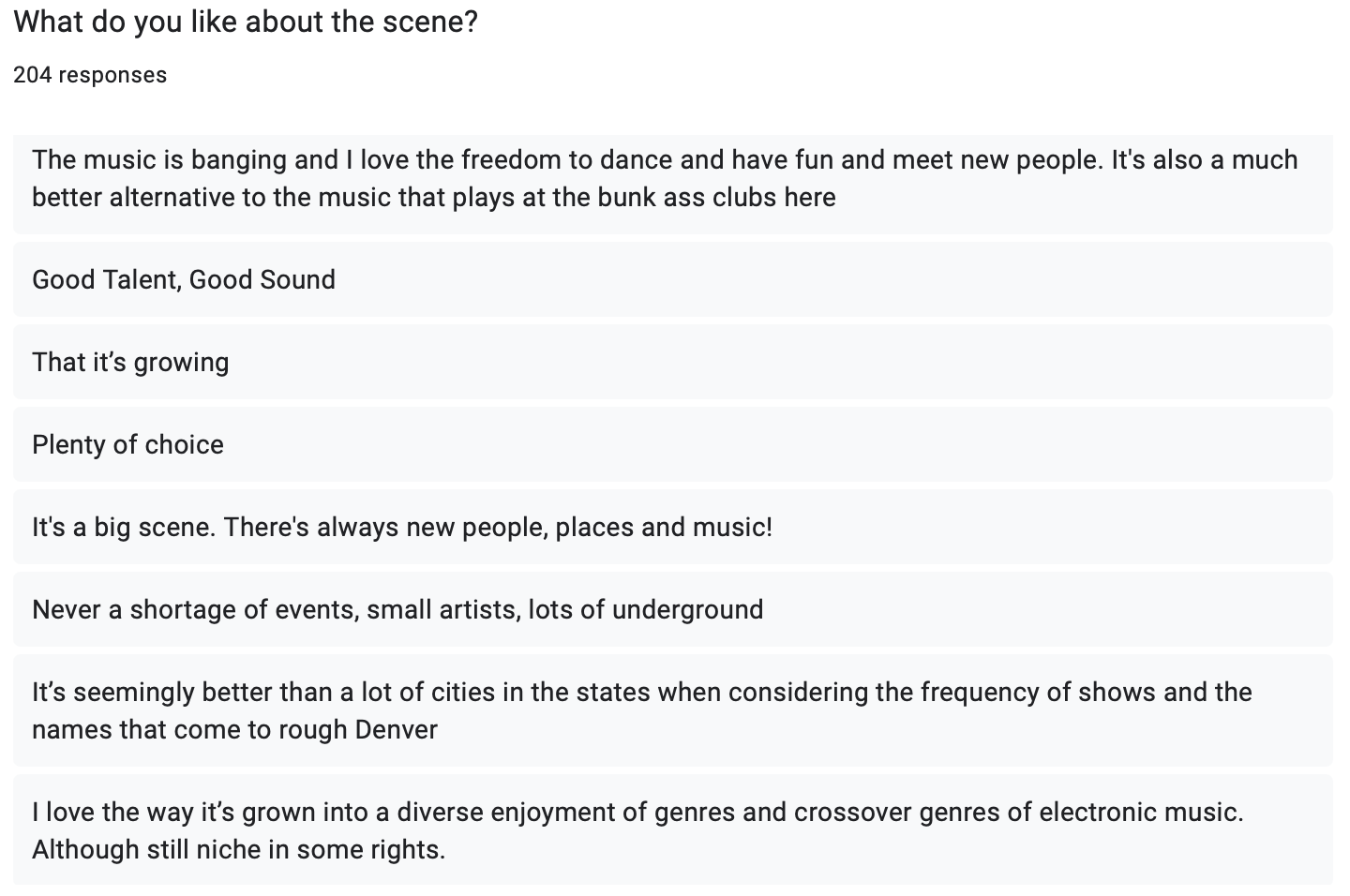

Likes:
The Denver electronic music scene stands out for its strong sense of connection and community. Many appreciate the wide variety of genres and events that make it easy to explore new sounds and meet new people. The atmosphere often feels welcoming and safe, with intentional spaces that center marginalized communities and allow folks to show up as they are. People value the open, respectful vibe and the chance to engage with music in a way that feels accessible and authentic.
Dislikes:
At the same time, not all spaces live up to those ideals. Some events still feel exclusionary—whether due to social gatekeeping, a lack of diverse representation, or events that feel more performative than genuine. Marginalized folks in particular have called out environments that feel unsafe or unwelcoming. Other common frustrations include repetitive or homogeneous lineups, inflated ticket and drink prices, and the creeping influence of big money or corporate interests that dilute the community-driven roots of the scene.
As mentioned in the process section, the data from the open-ended survey questions and interviews were organized into themes that reflect the voices of community members. These themes fall into two broad categories: "Within Our Reach" and "Beyond Our Control." I will identify each theme and summarize the key insights, supported by relevant quotes from participants.
Within Our Reach:
Safety & Accountability
People come to the dance floor for release, whether that is through music, connection, dance, or all the above. A safe, welcoming, inclusive dance floor has the power to make a huge impact on an individual. Participants are reporting deep concern about safety, from predatory behavior and unchecked abuse to a general lack of harm reduction and accountability in our spaces. While the term “safe space” is often used, follow-through and accountability are inconsistent or missing altogether.
Intentional Curation
The scene is sustained by independent organizers and DIY shows that carve out vital space beyond the mainstream. Participants value thoughtful, values-driven decisions—who’s playing, why, and how the experience is shaped. For many, it’s about more than just a party; it’s about building meaningful spaces and preserving culture. Participants expressed concern over the lack of diversity in bookings, noting a pattern of repetitive lineups that overlook femme, queer, and BIPOC talent within the local scene.
Community Building
Show goers share that the Denver scene is overall welcoming, supportive, and accessible. Many people value the friendships and connections made within the scene, as well as the sense of mutual support among artists, promoters, and attendees. While a deep appreciation for community exists, many also note exclusion, cliques, and missed opportunities for deeper connection and professional growth.
Beyond Our Control:
Commercialization
Many respondents expressed frustration with the growing corporate influence on Denver’s nightlife, criticizing those in power who are disconnected from the culture they profit from. There’s a sense that commercialization has drained the spirit of the scene, replacing community-driven values with profit motives and superficiality. Local artists are extremely underpaid compared to headliners, exposing a growing divide between the underground and aboveground.
Venue & Scene Limitations
Denver’s infrastructure for electronic music is often described as fragmented, underdeveloped, and limiting. While there are strong DIY efforts and a handful of dependable venues, many artists and promoters feel there's no clear path to growth. The dominance of mid-sized venues with little room for expansion, paired with venue turnover and corporate control, has led to a sense that the scene lacks a strong identity or long-term foundation. This has made it harder for local talent to rise and for marginalized communities to feel truly welcomed in these spaces.
Financial & Legal Struggles
Putting on events in Denver’s electronic music scene comes with intense financial strain and legal red tape that can discourage even the most passionate organizers. Independent promoters report operating at a loss, despite booking high-caliber talent, due to venue costs, licensing fees, and the lack of scalable spaces. Liability concerns, insurance requirements, and the need to navigate city regulations turn passion projects into complex business ventures.
What We Can Do
It you’re looking for ways to improve—this is the section to pay attention to. The goal of this project wasn’t just to collect data, but to turn it into something actionable. Within each theme, I break down what different roles in the scene can do, with examples and relevant resources. While I offer a framework, the next step is ours to take collectively. This isn’t about doing everything—it’s about making small, meaningful improvements. Let this data inspire us toward creative, collaborative solutions that reflect the needs and values of our community.
Safety & Accountability
True safety means designing spaces with care, responding to harm with intention, and embedding trust through clear expectations—not just having security at the door.
Intentional Curation
True intentionality means booking with purpose, nurturing new talent, and using events to reflect collective vision—not just crowd-pleasing.
Community Building
True community requires intentional care: showing up for one another, building inclusive cultures, and making space for newcomers. It doesn’t just happen—we have to build it.
Final Thoughts
If there’s one thing I want to emphasize that hasn’t already come through in this write-up, it’s that we are part of a system—a hierarchy of subsystems. The underground is our system, and it’s the one we have the most control over. Even when the larger systems are failing us, we still have each other. Ideally, all of these systems would work together in harmony toward a shared goal. But the reality is, we often don’t share the same goals or values. That’s where things break down.
Many venues, promoters, and even some artists aren’t aligned with the values this project represents. Yes, venues need to stay financially viable, but when they lose sight of their vision or operate inconsistently, they lose their people. We have to acknowledge the challenges, whether it’s the economy, interpersonal issues, or lack of solid business strategies, but when safety is compromised, you lose community. Once that trust is broken, it’s incredibly hard to rebuild. We can tell when safety and community are being promoted but not actually executed—that’s exploitation. If you are capitalizing on this culture without living up to its values, you’re part of the problem.
The data shows that venues are the subsystem where most of the frustration is coming from—probably because they feel the most out of our direct control. It’s also worth reiterating that many venue owners didn’t complete the survey, let alone opt into an interview. Unfortunately, I can’t speak much from their perspective because I wasn’t able to gather much data (which is why they are not represented in the section above). I hope venue owners will take the time to read this and gain some perspective. When we do see venues that align with our values, we need to show up and support them. Venues are a key part of this system—they bring in international talent and can house large crowds. But we also need to ask: at what cost? The truth is, more local party series are booking big talent on their own while staying true to the roots.
The underground is growing and thriving, born from our frustrations with current venues and systems. It's a response to a need for something more genuine, more in line with our values. A lot of us act on the change we want to see by creating our own thing—which is beautiful. But in doing so, did we think about how to build through collaboration, not just independently? As we continue to build, we should think about how we can combine our knowledge, connections, and resources to provide the best possible experience for everyone involved. Let’s focus on improving the spaces we gather in by holding each other accountable, staying true to what we believe in, and ensuring that our growth is rooted in the culture we want to cultivate.
